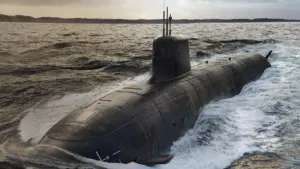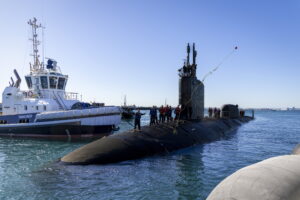Australian officials on Thursday said they selected Britain’s BAE Systems along with Australian submarine builder
ASC Pty Ltd. to build Australia’s future SSN-AUKUS nuclear-powered attack submarines.
The government said they will work to establish the foundation to this submarine project, ultimately leading to the establishment of a “long-term incorporated joint venture within Australia.”

ASC has been maintaining Australian submarines for decades and built the Collins-class vessels that SSN-AUKUS seeks to ultimately replace.
Under the AUKUS plan among the U.S., Australia and the U.K., the SSN-AUKUS design will be shared between the U.K. and Australia, but both building them separately. The boat is set to use technology from all three countries but based on the U.K.’s originally next generation submarine design that BAE is leading.
The first Australian SSN-AUKUS boat is expected to be ready in the early 2040s. In the meantime, the U.S. plans to sell three to five Virginia-class submarines to Australia in the 2030s.
The Australian Defense Ministry noted BAE’s role “ensures an integral connection between the SSN-AUKUS design led by BAE Systems in the U.K., where Australian experts are already working alongside their peers, and the SSN-AUKUS build strategy in Australia.”
BAE is the U.K.’s main long-term submarine build partner, having worked on nuclear-powered submarines for over six decades.
“We’re extremely proud of our role in the delivery of this vitally important, tri-nation submarine programme. Our selection as a partner in Australia, alongside ASC, recognizes our role as the U.K.’s long-term submarine design and build partner and as a key player in Australia’s maritime enterprise and wider defense landscape,” BAE Systems chief executive Charles Woodburn said in a statement.
Woodburn also said they are already “making good progress on the design and development of the next generation submarine in the U.K. where we have more than 1,000 people working on the SSN-AUKUS program and major infrastructure investment underway.”
The ministry said ASC will conduct sustainment of Australia’s nuclear-powered submarine, starting with the Virginia-class boats (SSNs) it will buy from the U.S.
“This decision recognises ASC’s long history and expertise in the sustainment of submarines in Australia, in addition to its established workforce and supply chain network,” the ministry said.
The government said the company will increase its sustainment capability in the lead up to acquiring the first SSN in the early 2030s.
“It will include significant workforce growth and the development of skills, knowledge and experience required to sustain Virginia-class submarines,” the ministry added.
The Australian government also said it will invest about $3.1 billion in the U.K. to help expand the Rolls-Royce plant that builds submarine nuclear reactors and contribute to the SSN-AUKUS design work.

This is on top of $3 billion Australia plans to invest in U.S. shipyards and separately spending funds to buy each of the Virginia-class submarines.
ASC is also set to provide sustainment support to visiting U.S. and U.K. submarines at HMS Stirling in the lead-up to the countries establishing Submarine Rotational Force-West as soon as 2027.
Australian Minister for Defence Industry Pat Conroy underscored AUKUS is being implemented at the right pace and this will be the “greatest industrial endeavor Australia has ever attempted, both in scale and technical complexity.”
Conroy noted the government plans for the AUKUS agreement to ultimately create more than 20,000 jobs for decades.
Beyond Australia, SSN-AUKUS will also replace the U.K.’s Astute-class attack submarines, with British deliveries planned to start in the late 2030s.